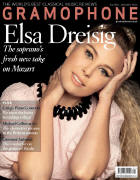Texte paru dans: / Appeared in: |
|
|
Outil de traduction |
|
|
Reviewer: Charlotte Gardner The Baroque era was especially good at publishing works under titles that gave no hint of the treasures enclosed within – yet another Op 3 for violin and orchestra, anyone? – so it’s perhaps rather fitting that ‘Sonatas for Three Violins’ has a veritable feast of invention and drama squirrelled beneath its unassuming heading. In fact, much as I’ve admired and enjoyed every single disc Johannes Pramsohler and his Ensemble Diderot have served up, this one might just be my favourite. For starters, their programme is full of variety: works spanning the course of a century from well-known names such as Purcell, Gabrieli and Pachelbel along with lesser-spotted composers such as Buonamente, Hacquart and Dornel. Then there’s the fact that the selection criterion has essentially been about theatricality, telling the story of the violin’s 17th-century emancipation from being used primarily in dance music to being the principal vehicle for the sonata and the concerto, the works presented in chronological order. The three-violin textures through which the musicians have chosen to tell this story are often so very rich and ornate, with constantly changing textures, that you completely forget that on paper this is very much a chamber recording, Pramsohler joined as usual by harpsichordist and organist Philippe Grisvard, plus just three others: fellow violinists Roldán Bernabé and Simone Pirri and cellist Gulrim Choï. Inevitably for this period, the very term ‘sonata’ is used in its loosest sense, and sometimes not at all. Take the programme-opener by Johann Sommer (c1570-1627), in which three violins embellish a chorale melody from Psalm 8, their music beginning in clean, sombre and subdued homophony before gradually building in drama and contrapuntal complexity in the style of an Italian instrumental canzona. What Pramsohler, Bernabé and Pirri have done with this is ravishing: even before we’re into the glorious interplay and tonal matching between their three luminous tones as they duck, dive, then reconnect (Grisvard on organ sticking to them like glue), each of those initial sustained chorale chords has sounded like a little shimmering prism of kaleidoscopic colours. There’s also the famous Canon by Johann Pachelbel (1653-1706), played from the only preserved music source; and when this 1838 source is presented in 4/4 time without a single articulation mark, the ensemble have taken that as their cue to chuck stateliness to the wayside and turn it into an ebullient exchange of imitations and bouncings off. One theory that developed between Pramsohler and his musicians as they explored these works was that scoring for three violins may have had an allegorical significance, musically retelling the thenpopular tale of the Judgement of Paris, in which the goddesses Hera, Athena and Aphrodite jostled in competition (naked, of course) for the attentions of Paris. It’s impossible not to be thinking of this through the Sonata decima by Flemish composer Carolus Hacquart (c1640-after 1700), where a serious introduction complete with fugal section is followed by a series of dancelike movements balancing flirtatious courtly decorum with overt virtuosity. Here, the violins’ joyous slinkings in and out of each other and jostlings for position, and Grisvard’s own glittering harpsichord flourishes, are certainly seductive. It’s so boring to cry ‘hurrah and bravo!’ yet again for Ensemble Diderot and their thoughtfully imaginative reassessments of the Baroque repertoire. But there you go. Hurrah and bravo.
|
|




